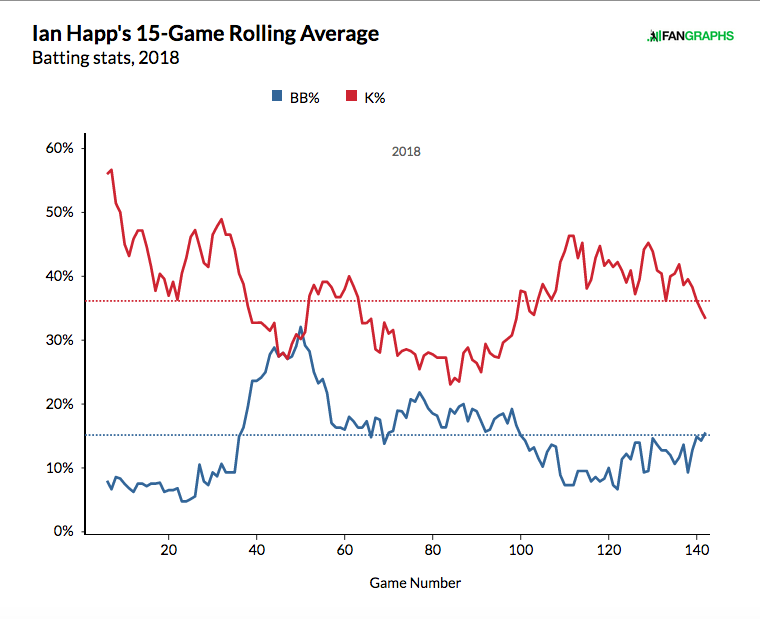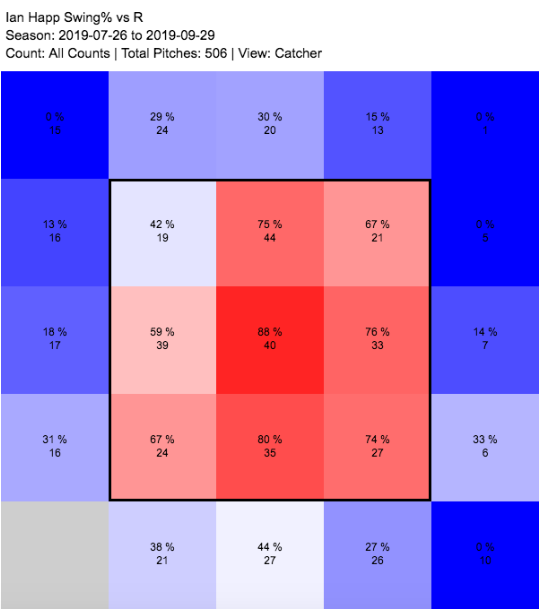Ian Happ Learned What Kind of Hitter He Is
It’s tough to imagine how the final few weeks of the 2019 regular season could have gone worse for the Chicago Cubs. Just two games back in the National League Central division on September 17, the team finished the year by losing 10 of its final 12 games, plunging not only out of the division race but out of the Wild Card hunt as well. It was a nightmarish run for the Cubs, but for one player on the team, that stretch represented the height of his season. Ian Happ, the young switch-hitting utility player, made 39 plate appearances in the final 14 games of the season and hit an astonishing .405/.436/1.000, crushing six homers and four doubles in that span. In the Cubs’ only two victories of that stretch, Happ went a combined 6-for-10 with three homers and two doubles.
It’s appropriate that it was Happ who enjoyed this success to close the season; it seemed like no one else on the team needed to finish the year on a high note as much as he did. He was the one who, just one year prior, had such a poor finish to the season that despite being one of the most exciting young players on his team, he went into the following spring training fighting for a job. Over the final two months of 2018, Happ hit just .192/.298/.333, with a wRC+ of just 72. Those two months tanked what had been a promising campaign, and had carryover effects well into the following year. In 56 spring training plate appearances in 2019, he ran on base and slugging percentages both south of .200.
This spring, it seems to be a different story, at least so far. Now carrying on his success, not struggles, from a previous season, Happ did this on Monday:
Kyle Hendricks CAN'T CONTAIN HIMSELF watching Ian Happ's solo shot.
( ?: @ESPN) pic.twitter.com/7QW5S14TR5
— Cubs Talk (@NBCSCubs) March 2, 2020
Then, he did this on Tuesday:
Ian Happ with a lead off HR! pic.twitter.com/QyT3Hn1lHz
— Aldo Soto (@AldoSoto21) March 3, 2020
Spring training stats are meaningless, until they aren’t. Last year, Happ performed so poorly in the spring that he was demoted to Triple-A, despite formerly being a highly-regarded prospect who appeared in 142 big league games in 2018. That stint turned out to last nearly four months, with Happ playing 99 games in Triple-A while the major league club struggled to separate itself in a tight playoff race. There was still a ton of potential in his bat, but he needed to redefine who he was as a hitter in order to be as successful as he could be. Fortunately for the Cubs, it appears he’s done just that.
Part of the reason Happ was sent to the minors for much of last season was to curb his astronomical strikeout rate. Strikeouts, of course, have become more acceptable in the modern game, but Happ’s 2018 tested those boundaries. He was fanned in more than 36% of his plate appearances, the third-highest rate in baseball among all hitters with at least 400 plate appearances. To his credit, he also maintained a very good walk rate — 15.2%, 11th-best in the majors — but the balance between the two wasn’t stable. As Happ struggled over his final two months, his strikeout and walk rates trended in opposite directions:

His time spent in Triple-A was a chance for Happ to tweak some things and return a better hitter, but instead of using the weaker competition to improve and build some confidence in himself, he merely looked average for the level. He still struck out more than 26% of the time, and his swinging strike rate actually went up slightly from the previous season. His ISO didn’t really budge and his batting average remained under .250, leading to a wRC+ of just 97 in 429 minor league plate appearances.
It was only after his promotion back to the majors that it became clear what his new strategy would be: Swing more. In 2018, Happ swung at 42.8% of pitches thrown to him. That put him in the 22nd percentile in baseball — as in, just 22% of hitters swung less often than he did. In 2019, his swing rate jumped to 51.7%, which put him in the 82nd percentile. No one in baseball experienced a bigger jump in their swing rate last season, and as this Baseball Savant graph shows, he upped his aggressiveness against pretty much everything.

This had a predictable effect on his walk rate, dropping it from 15.2% to 9.6% — the third-biggest drop of the year. But it also knocked his strikeout rate from 36.1% to 25%, which was the biggest drop of the year. The new approach resulted in a slash line of .264/.333/.564, good for a career-best 127 wRC+ in 156 plate appearances. His .300 ISO would have placed him in the top eight qualified hitters in baseball.
Broadly speaking, it isn’t typically the best idea for any given hitter to suddenly begin swinging more often. Part of the reason is that more swings leads to fewer walks, and fewer walks are often bad news. But another part of why it can be dicey is because selectivity is so important. Every swing a batter takes has a chance to be the one that ends a plate appearance, so it’s crucial for hitters to make sure what they’re swinging at gives them a good chance to do damage, lest you risk giving away an at-bat on a pitcher’s pitch.
There’s a flip side to that, though. Sure, waiting for the right pitch is great, but get too picky, and you’re likely to miss a few hittable pitches early in the count and set yourself up to have to battle later. Some hitters are built to thrive in those situations, building an entire offensive identity around it. But if you’re someone who has a high swinging strike rate, you’re less likely to be able to do well in deep counts. Last year, Mariners slugger Daniel Vogelbach posted the lowest swing rate in the majors, and had a swinging strike rate of 8.7% — two and a half points lower than league average. Other ultra-selective hitters, such as Mike Trout, Alex Bregman (I know), and David Fletcher have even lower whiff rates.
But when Ian Happ posted baseball’s 45th-lowest swing rate in 2018 (min. 400 PAs), he did so while also carrying the ninth-highest swinging strike rate. Of the hitters who whiffed at least as often as Happ, the closest to him in swing rate was Joey Gallo, who was 127th in the majors in swing rate that year.
The name of the game, then, is finding the ideal balance to not only maximize what each swing is capable of, but to also find out how many of those swings you can put together before sacrificing your overall quality of contact. In 2018, Happ posted a barrel rate of 12.2%, and an xwOBACON of .449. Those are near-elite numbers, each well above the 90th percentile in baseball. But the combination of how little he swung and how many of those swings missed meant that he was rarely making contact at all. His xwOBACON was terrific, but his expected batting average — which, of course, takes into account all the strikeouts — was just .210, one of the worst in the sport.
The mission for Happ in 2019 was to elevate his contact — not on a per-swing basis, per se, but the number of total times he made contact throughout the season. And that’s exactly what he did. That major league-leading K% improvement happened despite his whiff rate barely dropping, going from 15.3% to 14.7%. And he did that while maintaining a barrel rate (13.7%) and an xwOBACON (.439) that were as good or better than they’ve ever been.
It isn’t often we compliment a hitter for becoming more aggressive, but that’s because greater aggressiveness often coincides with a player getting fooled more often. When I investigated a similar phenomenon in Jesse Winker last season, I discovered that he was no longer laying off changeups the way he used to. Swinging at more pitches outside the strike zone is pretty unambiguously bad, and Happ’s chase rate went up substantially overall in 2019. But if you’re zeroing in on where Happ improved his swing rate the most in 2019, most of his aggressiveness was pointed at the middle of the plate.


I singled out Happ’s appearances from the left side of the plate, since that is where 80% of his PAs took place, and the sample of pitches he saw batting right-handed was too small to mean much. In these images, you can see Happ expanding outside the zone a little high, a little outside, and a little low and away. But mostly, the biggest increases in swing rate happen inside the zone — a 15% jump middle-middle, 18% up and in, 19% low and away. This is a hitter trusting himself to punish strikes and pulling the trigger more liberally in order to capitalize more often, even if it comes with the expense of a few more chases.
This should all be good news for a Cubs team that is could very much benefit from more offense up the middle of the field. Javier Báez is a stud, but a 114 wRC+ like he posted in 2019 isn’t exactly something to scream from the mountaintops about, and behind him, the options range from fine (David Bote) to bad (Albert Almora Jr.) to bad and gone (Addison Russell). Happ would be a big help, but it’s essential for him to continue building on what he should have learned last season. There are great hitters at both ends of the swing rate spectrum. In his short career, Happ has already gotten a taste of life on both of those sides. It seems clear which one suits him best.
Tony is a contributor for FanGraphs. He began writing for Red Reporter in 2016, and has also covered prep sports for the Times West Virginian and college sports for Ohio University's The Post. He can be found on Twitter at @_TonyWolfe_.

Addison Russ isn’t gone; he’s just a pitching prospect in the Phillies system.